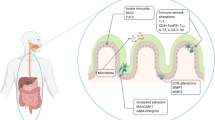Abstract
Background
Acute severe colitis (ASC) is conventionally diagnosed by Truelove and Witts’ criteria which are non-specific and can be affected by other pathologic conditions. Fecal calprotectin (FCP) is a gut-specific marker of inflammation which can predict short-term outcomes in patients with ASC. We aimed to define the role of FCP in the diagnosis of ASC.
Methods
This prospective observational cohort study included adult patients (> 18 years) with ulcerative colitis (UC) for whom FCP was measured and was under follow-up from April 2015 to December 2016. Patients were divided into two cohorts: (1) all consecutive hospitalized patients with ASC as defined by Truelove and Witts’ criteria; (2) outpatients with active UC (defined by Mayo score) who did not fulfill Truelove and Witts’ criteria. FCP levels were compared between the two cohorts, and a cutoff for FCP to diagnose ASC was determined.
Results
Of 97 patients, 49 were diagnosed with ASC (mean age: 36.1 ± 11.9 years, 36 males) and 48 with active UC (mean age: 37.9 ± 12.4 years, 25 males). Median FCP levels were significantly higher in patients with ASC [1776(952–3123) vs 282(43–568) µg/g, p < 0.001] than mild to moderately active UC (n = 48) or moderately active UC [n = 35, 1776(952–3123) vs 332(106–700) µg/g, p < 0.001]. A FCP cutoff of 782 μg/g of stool had excellent diagnostic accuracy, with an area under the curve of 0.92(95% CI 0.87–0.97), sensitivity of 84% and specificity of 88% to differentiate ASC from active UC.
Conclusion
FCP could differentiate ASC from mild to moderate patients with UC, but requires validation before clinical use.




Similar content being viewed by others
References
Dinesen LC, Walsh AJ, Protic MN, et al. The pattern and outcome of acute severe colitis. J Crohns Colitis. 2010;4:431–437.
Edwards FC, Truelove SC. The course and prognosis of ulcerative colitis. Gut. 1963;4:299–315.
Truelove SC, Witts LJ. Cortisone in ulcerative colitis; preliminary report on a therapeutic trial. Br Med J. 1954;2:375–378.
Yip R. Final report of the 1995 Viet Nam National Nutrition Anemia and Intestinal Helminth Survey: a recommended plan of action for the control of iron deficiency for Viet Nam. U N Child Fund Indones. 1996.
Ashavaid TF, Todur SP, Dherai AJ. Establishment of reference intervals in Indian population. Indian J Clin Biochem IJCB. 2005;20:110–118.
Fagerhol MK. Calprotectin, a faecal marker of organic gastrointestinal abnormality. Lancet Lond Engl. 2000;356:1783–1784.
Menees SB, Powell C, Kurlander J, Goel A, Chey WD. A meta-analysis of the utility of C-reactive protein, erythrocyte sedimentation rate, fecal calprotectin, and fecal lactoferrin to exclude inflammatory bowel disease in adults with IBS. Am J Gastroenterol. 2015;110:444–454.
Schoepfer AM, Beglinger C, Straumann A, et al. Fecal calprotectin more accurately reflects endoscopic activity of ulcerative colitis than the Lichtiger Index, C-reactive protein, platelets, hemoglobin, and blood leukocytes. Inflamm Bowel Dis. 2013;19:332–341.
D’Incà R, Dal Pont E, Di Leo V, et al. Can calprotectin predict relapse risk in inflammatory bowel disease? Am J Gastroenterol. 2008;103:2007–2014.
Gisbert JP, Bermejo F, Pérez-Calle J-L, et al. Fecal calprotectin and lactoferrin for the prediction of inflammatory bowel disease relapse. Inflamm Bowel Dis. 2009;15:1190–1198.
García-Sánchez V, Iglesias-Flores E, González R, et al. Does fecal calprotectin predict relapse in patients with Crohn’s disease and ulcerative colitis? J Crohns Colitis. 2010;4:144–152.
Frin A-C, Filippi J, Boschetti G, et al. Accuracies of fecal calprotectin, lactoferrin, M2-pyruvate kinase, neopterin and zonulin to predict the response to infliximab in ulcerative colitis. Dig Liver Dis Off J Ital Soc Gastroenterol Ital Assoc Study Liver. 2017;49:11–16.
Jain S, Kedia S, Bopanna S, et al. Faecal calprotectin and UCEIS predict short-term outcomes in acute severe colitis: prospective cohort study. J Crohns Colitis. 2017;11:1309–1316.
Dignass A, Eliakim R, Magro F, et al. Second European evidence-based consensus on the diagnosis and management of ulcerative colitis part 1: definitions and diagnosis. J Crohns Colitis. 2012;6:965–990.
Silverberg MS, Satsangi J, Ahmad T, et al. Toward an integrated clinical, molecular and serological classification of inflammatory bowel disease: report of a Working Party of the 2005 Montreal World Congress of Gastroenterology. Can J Gastroenterol J Can Gastroenterol. 2005;19:5A–36A.
Schroeder KW, Tremaine WJ, Ilstrup DM. Coated oral 5-aminosalicylic acid therapy for mildly to moderately active ulcerative colitis. A randomized study. N Engl J Med. 1987;317:1625–1629.
Author information
Authors and Affiliations
Contributions
Vineet Ahuja is the guarantor of the article, SK was involved in data acquisition, data analysis and drafting the manuscript, SJ and SG contributed to data acquisition and critical revision of the manuscript for important intellectual content, VS helped in analysis of fecal calprotectin, SB, DPY, PS, SP, NRD, SPLT, GM were involved in critical revision of the manuscript for important intellectual content, VA helped in study concept and design, drafting the manuscript and critical revision of the manuscript for important intellectual content. All authors have made significant contributions to the manuscript and agree with the content of the manuscript.
Corresponding author
Ethics declarations
Conflict of interest
None to declare.
Rights and permissions
About this article
Cite this article
Kedia, S., Jain, S., Goyal, S. et al. Potential of Fecal Calprotectin as an Objective Marker to Discriminate Hospitalized Patients with Acute Severe Colitis from Outpatients with Less Severe Disease. Dig Dis Sci 63, 2747–2753 (2018). https://doi.org/10.1007/s10620-018-5157-6
Received:
Accepted:
Published:
Issue Date:
DOI: https://doi.org/10.1007/s10620-018-5157-6




